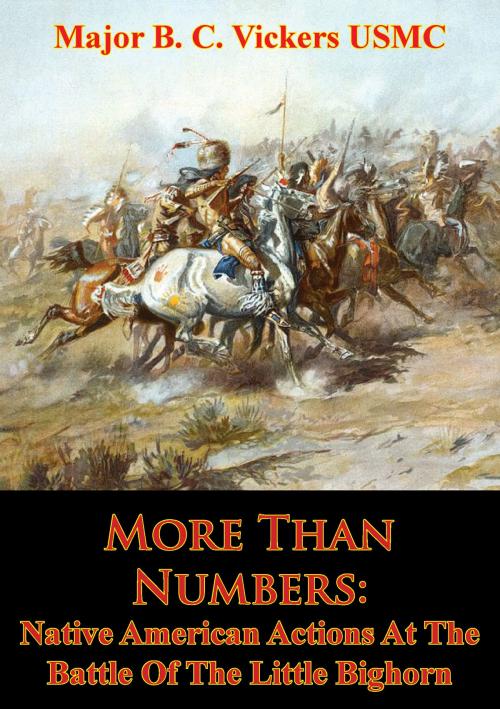More Than Numbers: Native American Actions At The Battle Of The Little Bighorn
Nonfiction, Social & Cultural Studies, Social Science, Cultural Studies, Native American Studies, History, Americas, United States, 19th Century, Biography & Memoir| Author: | Major B. C. Vickers USMC | ISBN: | 9781786253880 |
| Publisher: | Normanby Press | Publication: | November 6, 2015 |
| Imprint: | Normanby Press | Language: | English |
| Author: | Major B. C. Vickers USMC |
| ISBN: | 9781786253880 |
| Publisher: | Normanby Press |
| Publication: | November 6, 2015 |
| Imprint: | Normanby Press |
| Language: | English |
There can be no argument that the numerical advantage the Indians held during the battle of the Little Bighorn was a decisive factor in their overwhelming victory. However, numbers alone did not solely guarantee that the Indians would be able to annihilate five companies of the 7th Cavalry, kill over one third of the soldiers in another three companies, and seriously threaten the destruction of the entire regiment. The mere fact that the Indians, who were supposedly wild savages, were able to kill over 260 well-armed soldiers while only losing between an estimated 30-40 of their own, with at least eight of these being non-combatants, indicates that the Indians did not defeat the 7th Cavalry by simply throwing bodies at them. Rather, the Indians earned their victory with good leadership and savvy tactical actions.
In the actual fighting, the Indians consistently used the terrain in expert fashion and combined fires and maneuver that overwhelmed the troopers’ ability to react to each new and developing threat. The Indians combined bases of fire (with many Indians using weapons far superior to that of the cavalry), infiltrated, and penetrated to isolate units on the battlefield and then pressed their attacks to a total tactical victory, literally annihilating Custer’s detachment. Although the cavalry did achieve complete surprise in their attack on the village, the Indians were able to quickly meet each new threat posed by the soldiers during the course of the battle and then react faster than the troopers during every subsequent event.
There can be no argument that the numerical advantage the Indians held during the battle of the Little Bighorn was a decisive factor in their overwhelming victory. However, numbers alone did not solely guarantee that the Indians would be able to annihilate five companies of the 7th Cavalry, kill over one third of the soldiers in another three companies, and seriously threaten the destruction of the entire regiment. The mere fact that the Indians, who were supposedly wild savages, were able to kill over 260 well-armed soldiers while only losing between an estimated 30-40 of their own, with at least eight of these being non-combatants, indicates that the Indians did not defeat the 7th Cavalry by simply throwing bodies at them. Rather, the Indians earned their victory with good leadership and savvy tactical actions.
In the actual fighting, the Indians consistently used the terrain in expert fashion and combined fires and maneuver that overwhelmed the troopers’ ability to react to each new and developing threat. The Indians combined bases of fire (with many Indians using weapons far superior to that of the cavalry), infiltrated, and penetrated to isolate units on the battlefield and then pressed their attacks to a total tactical victory, literally annihilating Custer’s detachment. Although the cavalry did achieve complete surprise in their attack on the village, the Indians were able to quickly meet each new threat posed by the soldiers during the course of the battle and then react faster than the troopers during every subsequent event.







![Cover of the book Recollections Of A Lucknow Veteran 1845-1876 [Illustrated Edition] by Major B. C. Vickers USMC](https://www.kuoky.com/images/2014/august/300x300/9781782895329-mqYG_300x.jpg)


![Cover of the book Small Unit Action In Vietnam Summer 1966 [Illustrated Edition] by Major B. C. Vickers USMC](https://www.kuoky.com/images/2014/august/300x300/9781782893608-HtjI_300x.jpg)


![Cover of the book MIG Alley: The Fight For Air Superiority [Illustrated Edition] by Major B. C. Vickers USMC](https://www.kuoky.com/images/2014/august/300x300/9781782896593-WGqd_300x.jpg)
![Cover of the book Air Force Heroes In Vietnam [Illustrated Edition] by Major B. C. Vickers USMC](https://www.kuoky.com/images/2014/august/300x300/9781782898986-uZYp_300x.jpg)
